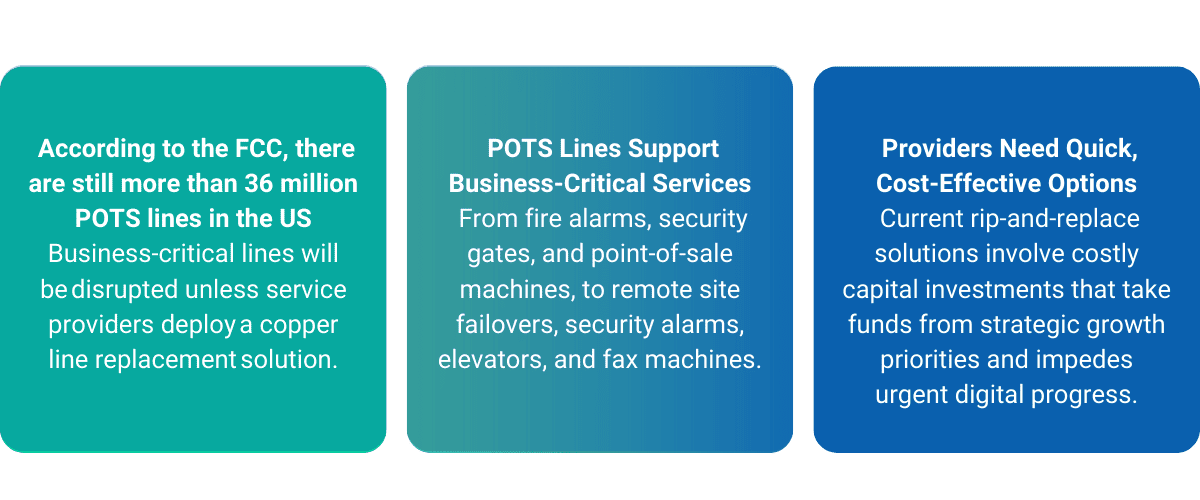
On the competitive battleground for new customers, growing telco revenue beyond voice is a top priority for today’s service providers. So in a tenured market like telecom, how can ISPs, MSPs, and cable, satellite, and fiber providers start growing telco revenue and new sources of income? The North American market is dominated by the big three telcos (AT&T, Verizon, and the combined T-Mobile/Sprint), which has caused service providers to become overly reliant on selling their network voice and data connectivity. With a US GDP growth rate of only 2.7%, telco service providers need to focus on post sales revenue and generating new revenue streams.
Previously, service providers were limited in their revenue generating avenues to public switched telephone networks (PSTNs) — only able to charge end users for local and international calls. Integrated services digital networks (ISDNs) opened a new revenue stream for service providers, and the launch of voice over internet protocol (VoIP) created an excess of opportunities. Many service providers now leverage VoIP to support media packets, data, and voice; however, it’s now cloud-based communication offerings that offer the best opportunities for growing telco revenue and service providers to generate new high-margin revenue streams while increasing their return on investment.
2022 is the time for service providers to focus on growing telco revenue by leveraging cloud-based cost savings, increased functionality, and simplified operations (while reducing costs). Consider these options:
Growing Telco Revenue Beyond Voice — Top 5 Service Provider Revenue Streams
1. IVR and Auto-Attendant Solutions
IVR or auto-attendant solutions allow service providers to create a group, or set up a queue, to route calls the way your customers want in a simple, intuitive interface.
Interactive voice responses (IVR) or auto-attendant solutions are highly sought by call centers. Service providers who offer a cloud-native softphone app as a contact center solution can create a new revenue stream while also being able to offer their direct end users carrier-grade communications and collaboration tools.
2. Video and Audio Conferencing
Save Time & Money as a UC Provider
Why connect your customers with voice and communication tools, only to turn them over to adjacent competitors like Zoom for their video conferencing needs? Growing telco revenue can be as easy as complementing your existing network with video and audio conferencing solutions to effortlessly become a unified communications (UC) provider — without additional costly hardware, truck rolls, or network expansions.
SMBs and enterprises are choosing to host less hardware on premises and are seeking flexible, cost-effective, mobile solutions. Offer your customers a broad range of powerful communication tools as a UC provider.

New Revenue Stream
With the ongoing decline in residential phone services, providers can move beyond voice to take advantage of unified communications solutions which have risen rapidly to become a vital and in-demand service. This means service providers can stem revenue loss from eroding residential sales while also growing telco revenue by incorporating cloud-based communication and collaboration solutions into their product suite. It is a pivot point for service providers to make the transition and compete with the over-the-top (OTT) vendors.
Easily Maintained
Centralized cloud-based management allows IT administrators to tailor any VoIP environment and instantly deploy features to all users, allowing you to redirect precious resources back to growing your business.

Software Updates
Automatic distribution of new software ensures your customers always have the latest security updates, compliance measures, and next-gen technology — without the need for intervention and maintenance from your team.

Seamless Provisioning
Best-in-class softphones (and their corresponding cloud communication platforms) with existing SBCs, IMS components, PBXs, VoIP switches, and more provide long-term viability and integration with your customers’ mission-critical business applications.
Cost Effective
Offer a better customer experience and save your IT team ongoing time and support costs by streamlining operations, automating key processes, and allowing customers to self-manage their services online.
3. Mobile Extension or UC Softphone
A softphone is essential to maximize the mobility of call centers — but not all softphones are created equal.
A softphone is a piece of software that allows users to make telephone calls over the internet via a computer or smartphone. It has all the features of a desk phone and typically expands the range of services you can access on a desk phone. Most importantly, a softphone allows your customers to take their work phone with them wherever you go. It can be installed on a laptop, tablet, or smartphone and frees service providers from tedious integration efforts and interoperability concerns.
Due to the worldwide shift toward remote work, many of your business customers are increasing using virtual desktop interfaces (VDI) to enable users to access their desktops remotely using their laptops, tablets, and even smartphones. VDI, however, doesn’t address the strategy of replacing location-locked devices like desk phones, and employees who are required to use desk phones to make and receive calls are unable to benefit from remote working.
Service providers who offer a cloud-native softphone app gain an edge over competitors that are unable to offer anywhere communications to their end users.
Growing Telco Revenue with Cloud Softphone Apps — They Benefit Everyone

Service Providers
Manual setup is obsolete with our streamlined deployment, simplified customer onboarding, and management tools. Increased speed to market means you can bring on new customers quicker and see an immediate return on investment.

SMBs & Enterprises
Superior flexibility and mobility supports increased productivity and employee satisfaction. In addition, organizations gain significant real estate and hardware savings with workforce mobility and endpoint flexibility.

End Users
By complementing your voice network with a softphone app, end users get the same experience on their personal laptops, smartphones, or tablets as they do in the office, which increases employee collaboration and desktop productivity.
4. Business Text Messaging
Business text messaging enables your SMB customers to reach their end users where they spend the most time — on their smartphones.
Business text messaging SaaS applications allow small and medium businesses (SMBs) to use their local, toll-free, or VoIP phone numbers to send and receive SMS and MMS messages. SMBs can easily resolve customer inquiries, send reminders, promote events, automate common responses, and more — all from the business phone number their customers already know and trust.
Many consumers not only prefer text messages to phone calls for short exchanges but also prefer companies that offer text messaging as a communication channel. In fact, almost 63% of consumers would switch to a company that offers it.¹ Because customers prefer texting, service providers can utilize business text messaging services to attract new SMB customers while growing telco revenue and increasing monthly recurring revenue from existing customers. In today’s ultra competitive cloud communications market, CSPs are looking for new ways to differentiate, increase margins, and growing telco revenue.
Complement Your Product Suite (Not Compete)
Business text messaging provides another communication channel that can be introduced into a customer’s solution suite — and best of all, it is in addition to, not a replacement of, existing communication solutions. For service providers offering this compelling solution, it is much harder to convince an SMB or enterprise customer to rip and replace an existing solution than it is to enhance their impact by adding another tool to their organization.
Limitless Commercial Applications
Business text messaging enables service providers to grow commercial revenue and stand out from the competition by delivering a compelling new communication service to their small and medium business (SMB) customers. With its limitless applications, BTM appeals to a wide range of SMBs including retailers, professional services firms, and home services companies.
5. POTS Replacement (Specialty Lines)
Why Providers Need an Immediate Plan
In 2017, the Federal Communications Commission (FCC) told telecom providers to begin sunsetting their plain old telephone service (POTS) lines, which has left service providers in the difficult position of either significantly increasing prices to maintain their legacy copper POTS lines or finding an alternative solution.
As it stands today, businesses have two options: a full rip and replace of their entire communications infrastructure or a digital POTS replacement solution. Most providers have invested considerable time and capital into their current infrastructures, making a full rip and replace cost exorbitant and time prohibitive.
As providers decide the best way to move forward, most will select a digital or cloud-based POTS replacement for flexibility, scalability, and low CAPEX. Here are the top benefits of a cloud-based cooper lines replacements solution:
- Future-Proof. Cloud solutions enable service providers to leverage next-gen technology with lower costs, enhanced reliability, and simplified migration to digital lines while continuing to support analog lines.
- Cost Reduction. With a turnkey, market-ready solution, providers can avoid large capital investments and eliminate unpredictable costs for ongoing maintenance, IT staffing, and training. Carrier-grade solutions typically have a flexible pricing model that delivers an immediate return on investment (ROI). If per-site pricing is available, end users can gain greater savings for multi-line sites.
- Single Solution Technology. It’s safe to assume that each of your business customers has at least one or two POTS lines that support business-critical applications. A single solution offering would allow service providers to replace every hardline connection with a cloud-based line.









